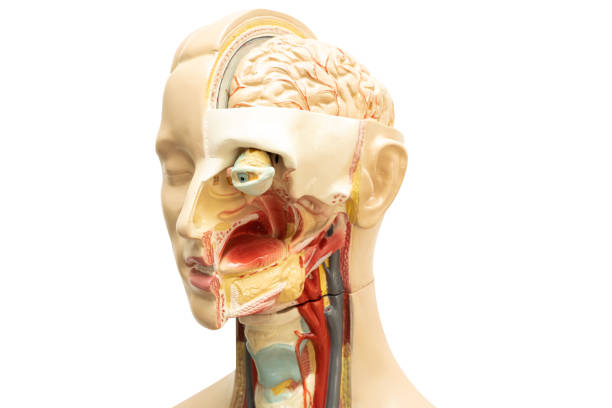The neocortex in the brain is a complex and vital structure that plays a central role in many of the higher cognitive functions that define human experience. As the most recent evolutionary development in the mammalian brain, the neocortex brain is responsible for advanced processes such as sensory perception, motor commands, spatial reasoning, conscious thought, and language. This extensive, six-layered sheet of neurons, which covers the cerebral hemispheres, is crucial to understanding the intricate workings of the human mind.
Structure of the Neocortex in the Brain
The neocortex is characterized by its layered structure, which consists of six distinct layers of neurons. Each layer has its unique type of cells and connectivity, contributing to the neocortex’s overall function. The six layers are:
- Layer I (Molecular Layer): The outermost layer contains few neurons and is primarily made up of dendrites and axons that interconnect different cortical areas.
- Layer II (External Granular Layer): This layer contains small pyramidal neurons and stellate cells. It plays a role in receiving input from other cortical regions.
- Layer III (External Pyramidal Layer): Composed of medium-sized pyramidal neurons, this layer sends projections to other cortical areas and is crucial for interhemispheric communication.
- Layer IV (Internal Granular Layer): A key layer for sensory processing, this layer contains stellate neurons that receive thalamic input.
- Layer V (Internal Pyramidal Layer): This layer consists of large pyramidal neurons that project to subcortical structures, including the brainstem and spinal cord, and are involved in motor control.
- Layer VI (Multiform Layer): The deepest layer, it contains various cell types and sends feedback connections to the thalamus, regulating thalamocortical communication.
The thickness and cellular composition of these layers vary across different regions of the neocortex, reflecting their specialized functions.
Evolutionary Significance of the Neocortex in the Brain
The neocortex is a relatively recent evolutionary addition to the mammalian brain. Its development is particularly pronounced in primates, with humans having the most expanded neocortex relative to body size. This expansion is believed to be associated with the complex social behaviors, language, and abstract thinking that are characteristic of humans.
The evolutionary advantage of a developed neocortex lies in its ability to process and integrate vast amounts of information, allowing for sophisticated decision-making and problem-solving. The increased surface area provided by the neocortex’s folded structure, with gyri (ridges) and sulci (grooves), facilitates more complex neural networks and higher cognitive functions.
Functions of the Neocortex in the Brain
The neocortex in the brain is involved in numerous functions that are essential to everyday life. These functions are generally divided into sensory, motor, and association areas, each contributing to different aspects of cognition and behavior.
Sensory Processing
The neocortex plays a critical role in sensory processing, where different regions are specialized for processing specific types of sensory information. For example, the occipital lobe, located at the back of the brain, houses the primary visual cortex, which is responsible for interpreting visual stimuli. The temporal lobe, located on the sides of the brain, contains the primary auditory cortex, essential for processing sounds. The parietal lobe, situated at the top of the brain, includes the somatosensory cortex, which processes tactile information such as touch, pressure, and pain.
These sensory areas receive input from the sensory organs through the thalamus and translate this information into perceptions that allow us to interact with and understand our environment. The neocortex’s ability to process and integrate sensory data is fundamental to our experience of the world.
Motor Control
The neocortex is also vital in controlling voluntary motor functions. The primary motor cortex, located in the frontal lobe, is responsible for generating neural impulses that control the execution of movement. It sends signals to the spinal cord and muscles to initiate and coordinate precise, voluntary movements.
Adjacent to the primary motor cortex are the premotor and supplementary motor areas, which are involved in planning and organizing movements before they are executed. These regions of the neocortex enable complex motor behaviors, such as playing a musical instrument or engaging in athletic activities, by integrating sensory feedback and refining motor actions.
Higher Cognitive Functions
One of the most distinctive features of the neocortex in the brain is its role in higher cognitive functions. These include abstract thinking, problem-solving, decision-making, and planning. The prefrontal cortex, located in the front part of the frontal lobe, is particularly associated with these executive functions. It allows for the evaluation of different strategies, the anticipation of future outcomes, and the regulation of behavior based on goals and social norms.
The neocortex is also involved in memory formation and retrieval, with different cortical regions interacting with the hippocampus to encode, store, and recall information. The integration of sensory and emotional information in the neocortex enables complex learning and the ability to adapt to new situations.
Language and Communication
Language is one of the most advanced functions associated with the neocortex. Specific areas within the neocortex, such as Broca’s area and Wernicke’s area, are crucial for language production and comprehension. Broca’s area, located in the frontal lobe, is involved in the motor aspects of speech, allowing us to articulate words and sentences. Wernicke’s area, located in the temporal lobe, is responsible for the understanding of spoken and written language.
These language-related areas of the neocortex are interconnected, allowing for the complex processing required for fluent communication. The ability to use language is a fundamental aspect of human culture and social interaction, and it is largely dependent on the proper functioning of the neocortex.
Plasticity of the Neocortex in the Brain
The neocortex exhibits a remarkable degree of plasticity, meaning it can adapt and reorganize itself in response to experience and learning. This plasticity is particularly pronounced during early development but continues throughout life.
For example, the neocortex can reorganize in response to sensory deprivation or injury. In individuals who are blind from birth, the visual cortex in the neocortex can be repurposed for processing other types of sensory information, such as auditory or tactile stimuli. Similarly, following brain injury, other areas of the neocortex may compensate for lost functions, a phenomenon known as cortical remapping.
The plasticity of the neocortex is also evident in learning and memory. Through processes such as synaptic plasticity, where the strength of connections between neurons changes, the neocortex can store new information and refine skills over time. This ability to adapt is fundamental to the brain’s capacity to learn and to recover from damage.
The Neocortex in the Brain and Consciousness
The neocortex is closely associated with consciousness, although the precise mechanisms by which it contributes to conscious experience remain a topic of intense research and debate. The neocortex’s role in integrating sensory information, generating perceptions, and enabling reflective thought suggests it is a central component of the neural basis of consciousness.
Some theories propose that consciousness arises from the interactions between different regions of the neocortex, which together create a unified experience of the self and the environment. The neocortex’s ability to process information in parallel and integrate diverse inputs is thought to be critical for the richness and complexity of conscious experience.
Disorders of the Neocortex in the Brain
Given its central role in cognition, the neocortex is implicated in various neurological and psychiatric disorders. Damage or dysfunction in specific areas of the neocortex can lead to a wide range of cognitive deficits and behavioral changes.
For example, damage to the neocortex in the prefrontal cortex can result in impaired executive function, leading to difficulties with decision-making, planning, and impulse control. Disorders such as schizophrenia and depression have also been linked to abnormalities in the neocortex, particularly in how different regions communicate and process information.
Autism spectrum disorder is another condition associated with atypical development and connectivity of the neocortex. Individuals with autism may have differences in how their neocortex processes sensory information, leading to challenges with social communication and behavior.
Epilepsy is a condition that can involve abnormal electrical activity in the neocortex, resulting in seizures that affect motor, sensory, or cognitive functions. Understanding the role of the neocortex in these disorders is crucial for developing effective treatments and interventions.
Research on the Neocortex in the Brain
Ongoing research on the neocortex in the brain aims to unravel the complexities of its structure and function. Advances in neuroimaging techniques, such as functional MRI (fMRI) and diffusion tensor imaging (DTI), have allowed scientists to explore the connectivity and activity of the neocortex in unprecedented detail.
Animal studies, particularly in rodents and non-human primates, continue to provide insights into the basic organization and functioning of the neocortex. These studies have revealed the importance of the neocortex in various behaviors and have identified potential mechanisms underlying its role in cognition and perception.
One area of active research is understanding how the neocortex develops and matures, both in terms of its cellular architecture and its functional connectivity. This research has implications for understanding developmental disorders and for designing interventions that can enhance brain plasticity and cognitive function.
Another exciting avenue of research involves the use of artificial intelligence and machine learning to model the neocortex’s functions. By creating computational models that mimic the neocortex’s processing abilities, researchers hope to gain a deeper understanding of how the brain performs complex tasks and how these processes can be replicated in machines.
Conclusion
The neocortex in the brain is a remarkable structure that plays a central role in the functions that define human experience, from sensory perception and motor control to higher cognitive functions such as language, memory, and consciousness. Its layered structure and extensive connectivity enable it to process and integrate vast amounts of information, making it essential for the complexity of human thought and behavior.
Understanding the neocortex is not only important for unraveling the mysteries of the brain but also for addressing a wide range of neurological and psychiatric disorders. As research on the neocortex continues to advance, it holds the promise of new insights into the workings of the mind and the development of innovative treatments for brain disorders.
The neocortex’s ability to adapt, learn, and recover from injury highlights its importance in both development and throughout life. As we continue to explore the intricacies of the neocortex, we move closer to a comprehensive understanding of what makes us human.




